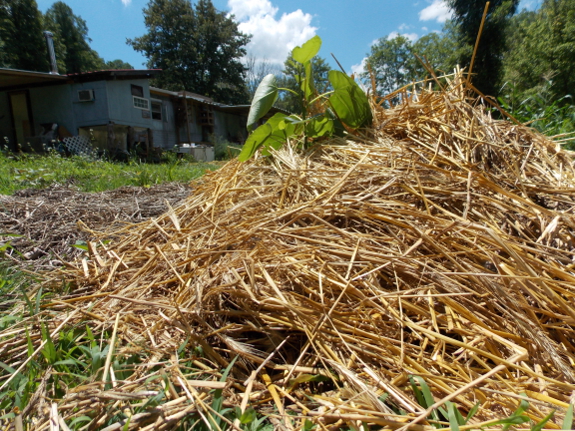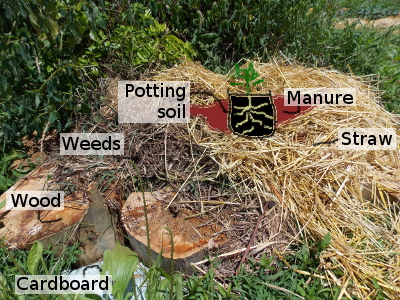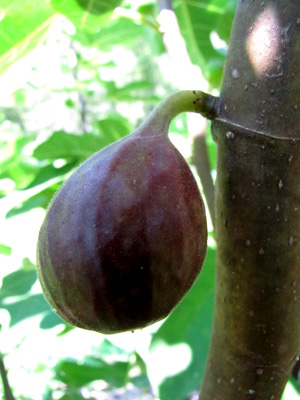
Raising trees out of wet soil with mounds

This wet summer has
proven to me that tree
mounds are even
more essential than I'd thought in the high-groundwater area of
the forest garden. We have five baby
figs ready to
go in the ground...or, rather, above it...so I've been figuring
out the easiest way to produce good soil that will stay high and
dry.
 My current method is a modified
kill-mulch/hugelkultur mound. I lay down a sheet of
cardboard as a weed barrier, layer on three or four
wheelbarrow-loads of weeds from the garden, and toss in any punky
firewood I find lying around. In a year or so, I could plant
into that as-is, but since I want to plant sooner, I make a
depression in the middle, pour a baby tree out of its pot with all
of the soil intact around its root ball, then add a bucket of
horse manure around the edges of the potting soil. I top it
all off with a straw mulch, and I'm done...for now.
My current method is a modified
kill-mulch/hugelkultur mound. I lay down a sheet of
cardboard as a weed barrier, layer on three or four
wheelbarrow-loads of weeds from the garden, and toss in any punky
firewood I find lying around. In a year or so, I could plant
into that as-is, but since I want to plant sooner, I make a
depression in the middle, pour a baby tree out of its pot with all
of the soil intact around its root ball, then add a bucket of
horse manure around the edges of the potting soil. I top it
all off with a straw mulch, and I'm done...for now.
 The trees will be
able to grow into the partially-composted manure nearly right
away, and will reach the woodier organic matter around the time it
starts to decompose. I suspect the weeds will rot down to
become just an inch or two of humus, but hopefully the addition of
punky wood will keep figs out of the groundwater longer.
I'll continue adding either hugelkultur
or weed donuts
around the plants, though, to give the plants dryish ground to
grow into over the years.
The trees will be
able to grow into the partially-composted manure nearly right
away, and will reach the woodier organic matter around the time it
starts to decompose. I suspect the weeds will rot down to
become just an inch or two of humus, but hopefully the addition of
punky wood will keep figs out of the groundwater longer.
I'll continue adding either hugelkultur
or weed donuts
around the plants, though, to give the plants dryish ground to
grow into over the years.
Last year, figs
proved themselves to be one of our easiest and most productive
fruit trees, so it's good to have some new varieties join the
club. I'll let you know if Black Mission and Dwarf can
survive our winters with
protection like
Chicago Hardy and Celeste did. Stay tuned for details next
spring (and for ripe figs in a month or so --- the photo above is
from last August).
Want more in-depth information? Browse through our books.
Or explore more posts by date or by subject.
About us: Anna Hess and Mark Hamilton spent over a decade living self-sufficiently in the mountains of Virginia before moving north to start over from scratch in the foothills of Ohio. They've experimented with permaculture, no-till gardening, trailersteading, home-based microbusinesses and much more, writing about their adventures in both blogs and books.
Want to be notified when new comments are posted on this page? Click on the RSS button after you add a comment to subscribe to the comment feed, or simply check the box beside "email replies to me" while writing your comment.

I'm assuming you don't get really strong winds. I'm curious about the implications for stability during wind storms of planting into mounds and encouraging the roots to avoid the water logged areas.
I've read that figs do tend to want to go deep and that actually boxing in the roots in some way is good for them. I think I heard this on the british show, Victorian Kitchen Garden, that at times they would even use very large stones, lining the planting hole (larger area for room to grow) and at times even use tombstones to ultimately contain the roots. I think they were talking about a 6 foot or 8 foot deep and equal side hole, not a typical planting hole.
I've been curious about root and tree stability during wind storms when planting into mounds.
Hi Anna. We intend to plant similar varieties of apples and figs on our Brandywine, WV homestead, but also intend to plant some other guild plants. Do you use this permie method? (adding nutrient accumulators. green manures, fruiting manures, etc. to the same parcel of space?) I'm just wondering if we should allow a the fruit trees a few years to gain some girth before overwhelming the space with other competing plants?
Thanks! Karen